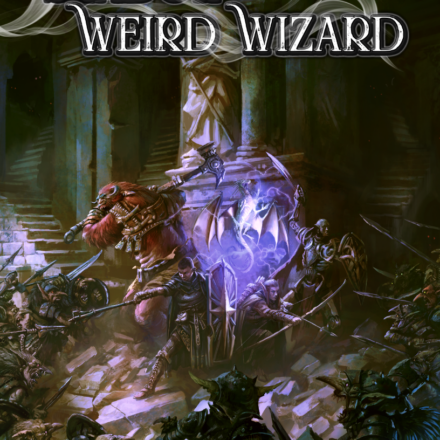Let me tell you about the schenanigans my friend and I pulled in the 4E game my wife runs last Sunday:
My wife is huge on custom magic items. Some are just little flavor differences, others are completely whole cloth inventions of hers. That’s how our party ended up with a magic levitating ship. While neutrally buoyant and able to be pulled with effort, it requires magic residuum (pricey stuff) to fly, and a lot of it, something akin to 1k gold worth for a mile of flight. Never mind how we managed to travel a few hundred miles in it and then end up stranded 200 miles from anywhere. That’s a different story. The crux of our problem last week was: Do we disenchant the ship for magic residuum, destroying it, strand it in the middle of the wilderness and hope we’d be able to come back for it later, split the team so that one half of us could go buy a team of horses and return, or some other option?
We eventually settled on spending a few hours looking for something suitable to pull the ship in the nearby unsettled wilderness then consigning ourselves to fate and disenchanting it and moving on. Good-bye magic flying ship…
As luck and a kind GM would have it, we managed to find something to pull our ship: a basilisk. Then our problem became how to convince a basilisk to drag our flying ship 200 miles. Since knowledge:Nature applies specifically to training only natural beasts, we couldn’t outright use that skill. Nor are there any mind effecting compulsions anymore. Our eventual plan? Have the rogue knock the basilisk unconscious with one of his daily powers and tie it up with a bedroll over its eyes. Once it regains consciousness, beat it with a stick until it learns not to struggle, then slowly untie it, limb by limb using stick beatings to teach it not to fight against it’s bonds. Eventually, we have a relatively docile basilisk with a bedroll over it’s eyes. Then we tie it to our ship, put a rabbit carcass on a long stick, and off we go.
Naturally, the DM was a bit incredulous. “Hey,” I said, “There’s no rules for taming basilisks in 4E. If there were, I’d use em, but there aren’t, so we’re doing this.” She allowed it, but ruled that because the basilisk was blindfolded and we were training it without any knowledge of actual animal training, travel was slow and the basilisk was still hostile. It was just biding it’s time to escape.
I had read A Quick Primer for Old School Gaming. the subject of my last post, just before the game and that exchange was a bit of a “Eureka” moment for me. In it’s attempt to simplify, simplify, simplify, 4E tossed out a lot of the rules for things like crafting, animal companions, familiars, spell research, etc… and a lot of people’s complaints (mine included) was that this narrowing of focus removed a lot of actions and playstyles from the realm of possibility. But that’s not really the case. Did I really get so forgetful of my RPG roots that I had taken the position that a lack of rules for owning a dog meant I couldn’t own one? Indeed I had.
But what’s more is that strangely, by focusing on little more than combat and skill checks, and therefor allowing for 1e style open play, 4E is, in a way, the closest spiritual successor to 1e in the history of DnD. Hear that 1e fanatics? Give 4E a try. It’s closer than you thought.

















Hear hear. That’s what I’ve been saying since 4e came out: fewer “official” rules means more wiggle room for homebrews and improvising.
(Telas dons his powder blue suit, and thumps his 1E DMG.)
Brothers and sisters, can I get an “Amen”?
The light has shined upon Brother Neagley from on high, where the Gygax himself, the EGG, the creator of all things RPG*, looks down upon us from behind the great GM’s screen in the sky. The Gygax has most certainly crossed to the other side, and has risen again, deep in the books that once bore your ire! (pause) Seek the old in the heart of the new, and ye shall indeed find it! Hallelujah!
Yes my friends, the hand of the Gygax can most certainly be seen, pushing aside the endless rules and leaving, dare I call it, a “Greyspace” (pause) upon which your own decisions will be writ large. The Gygax is reborn like a phoenix, bringing freedom to the masses, if they have but the wit to see it, and the power to grasp it.
Did not Plato himself say, “Good players do not need more rules to tell them how to play, and bad players will find their way around them”? And does not your heart say, “Play not with munchkins, for that way lies madness and endless rules arguments”?
Brothers and sisters, open your PHBs to page 14, bow your heads, and let us play…
( * The Son of Arn has been declared a false prophet, though many in the congregation secretly worship him as well.)
Telas scares me sometimes. Anyone else? 🙂
Great article, good point, and awesome lesson to be learned – you make the game what it should be for your group. The game designers are really only suggesting a way to play.
Since Brother Telas is preaching the good word, someone around here has to play Devil’s Advocate 😉
(Walt dons his white Texas oilman suit with the black shoestring tie and lights up a cigar).
If the lack of codification in 1e was salvation as it were, then why did so many of the faithful feel the need to clutter it up with house rules?
In the same vein (taps off his ash), why did so many of the fantasy heartbreakers during that particular decade of greed (tips his hat) add more rules rather than less?
And why did the Gygax himself feel the need to add things like non-weapon proficiencies? Why were two whole books dedicated to the proposition that dungeoneering and wilderness adventuring needed expansions and codifications?
Now I grant you all that Brother Matthew Finch eloquently extolled the virtues (blows out a stream of smoke) of old-school gaming, but friends, I would humbly submit that, to the best of my old-school recollection, the 1e thief class did include a Find/Remove Traps skill in his repertoire. So while I’m willing to concede that 1e did not reduce trap-finding to a single die roll, it did require two (percentage dice, unless you were using a d100. I believe Brother Martin is still waiting for his d100 die to stop rolling from a check he made in 1988).
So, my friends, I would conclude that “old school gaming” is more a product of personal style than 1e’s early attempts at rules codification, or lack thereof (rubs out his cigar).
Hey, that was fun! lol. Great article, Matt!
The ongoing 3.x/4e wars in D&D always remind me of the Mac vs. PC ad campaign. The Mac selling point of “just turn it on and start having fun” vs. Apple’s characterization of PC’s of unreliable and needlessly complicated. I could go on about the parallels with 4e/3.x for some time, but it boils down to the idea that Mac is just wrong for asserting that complicated != fun. Thankfully, unlike with Macs, the 4e design allows you to choose your own levels of complexity, and gets out of your way for noncombat activities.
Back, heathen! (Whispered: Hey, can I borrow that tie later? I’ve got a date with the organist.)
Did you not know that only the reborn sinner has the knowledge of the many sides of the Eternal Conflict of Rules and Freedom? Only he who has seen the stifling morass of 2E, dealt with the cunning artificers of 3.5, and suffered under the paralyzing freedom of 0E will know when to rely on the rules, and when to wing it.
Did you not gaze lustily at the New Rules as they were doled out in Dragon Magazine? We all did, brother.
Did you not buy hundreds of dollars of sourcebooks, unknowingly weakening your creativity with the tasteless gruel therein? I know I did, brother.
And will we do it all again, starting this month with Martial Power? Burn me once, shame on you. Burn me twice, and it better be a really good sourcebook, with evocative illustrations and an index that actually works.
Oh, hell, who am I kidding. We love crunch, even when it gets in our way…
@Walt Ciechanowski – I agree with your assessment over the rules. I would also want to add to it that in my opinion, increasing the rules can help both the players and the GM.
Balanced rules can help by providing a reference point. The best references are researched and playtest before being put into use. A company like WoTC has the resources to do both, while a single GM would have to guess his way around it, making assumptions that may or may not change the balance of the game.
I would prefer being guided by the rules rather than guessing my way during play.
You guys are killing me. In all sorts of ways. And Telas’ proselytizing is especially hilarious…
But seriously…as I have said in dozens of manners on tens of sites, let the rule system you play mirror the type of game you want to play. I went skill based decades ago and wouldn’t touch anything made by WotC with a standard 10′ pole (regardless of the real encumbrance) without a good sized donation to my children’s college accounts.
I think Walt is right about what was intended in 1e, and personally, as a GM who runs games with Combat as a minor component, I like a system that not only has a lot of non-combat abilities but provides guidance for creating more of them.
Winging it just tells me that someone is running a game that the system is not suited for.